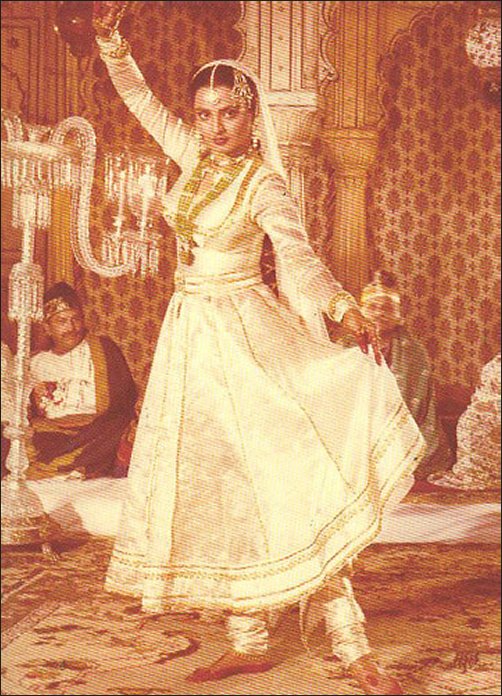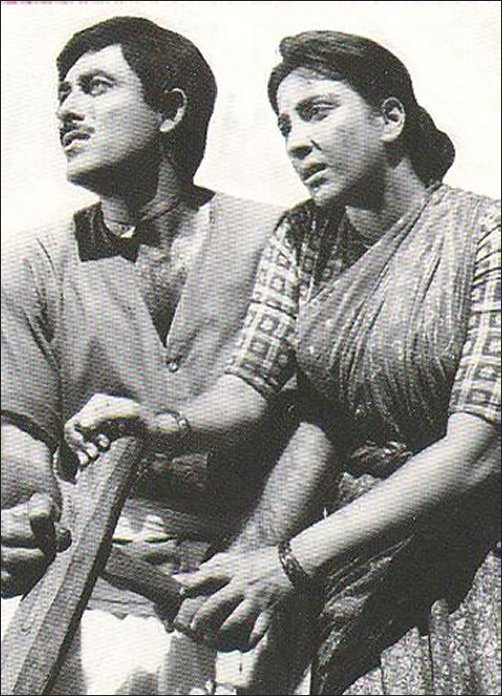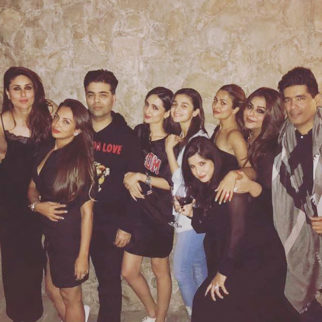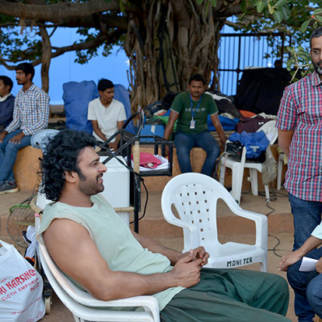Book excerpts of ‘The History Of Indian Film Music’
-
 Read More">The History Of Indian Film Music The excessive (as the listener perceived it then) degeneration in lyrical and musical standards – Bappi Lahiri also unleashed the cacophonous Padmalaya-Jeetendra genre of scores full of cheap lyrics and raucous Kishore duets 0 led to a mass rejection of such film music in this decade. And thus wasRead More
Read More">The History Of Indian Film Music The excessive (as the listener perceived it then) degeneration in lyrical and musical standards – Bappi Lahiri also unleashed the cacophonous Padmalaya-Jeetendra genre of scores full of cheap lyrics and raucous Kishore duets 0 led to a mass rejection of such film music in this decade. And thus wasRead MoreThe History Of Indian Film Music
The excessive (as the listener perceived it then) degeneration in lyrical and musical standards - Bappi Lahiri also unleashed the cacophonous Padmalaya-Jeetendra genre of scores full of cheap lyrics and raucous Kishore duets 0 led to a mass rejection of such film music in this decade. And thus was born a parallel music industry of bhajans and ghazals.
By definition ethnic and traditional, the movement generated a bevy of trained artistes or had them emerge out of the struggling shadow, with Jagjit and Chitra Singh, Rajendra and Neena Mehta, Bhupinder (who had never made it really big in films) and Mitalee Singh, Anup Jalota, Talat Aziz, Penaz Masani and others, and their albums often outsold most film soundtracks - something unthinkable till that point of time in recorded music in India.
But the so-called degenerate decade (which also spawned widespread lifting of Western numbers, especially by R.D Burman, Rajesh Roshan, Bappi Lahiri and Laxmikant-Pyarelal) had a very healthy flipside: unlike what happened post-2004, there were crusaders at work, helped by evolved audiences. So unlike in the millennium when some great musical and lyrical works went unsung, this generation of listeners for whom songs were still like friends to be treasured, went all out to welcome every great score and song that came in.
And so even unsuccessful films like Umrao Jaan, Kudrat and Saagar had hit music, and but for a few standout exceptions like Deedaar-E-Yaar, Jaag Utha Insan, Sur-Sangam, Batwara and Naqab (whose parent films also emerged non-starters) great music scores like Nikaah, Prem Rog and Hero were taken to the skies.
Revival Of Melody
In 1985, Laxmikant-Pyarelal dealt a decisive blow to the prevalent cacophony with Pyar Jhukta Nahin, a modest film that became huge at the box-office and placed "disco deity" Mithun Chakraborty in the A-league of social dramas. It was rapidly followed by R.D Burman's Saagar, Ravindra Jain's Ram Teri Ganga Maili and L-P's Meri Jung and Utsav and the cacophony was decimated.
The effects of this crusade were not immediately felt, though 1986-87 had its share of melody-based winners like Karma, Naam, Janbaaz Mr India, Sindoor and Khudgarz.
But in 1988, Anand-Milind, sons of the gentle Chitragupta, brought about a major revolution with Nasir Husain's Qayamat Se Qayamat Tak, along with L-P's Tezaab and Rajesh Roshan's Khoon Bhari Maang.
Author: Rajiv Vijayakar -
 Jaanewalon Zaraa, one of the six all hit songs from the 1964 Golden Jubilee musical Dosti, Read More">the film that made Laxmikant-Pyarelal take off in a big way after Roshan turned it down That all five mammoth talents eminently succeeded in this is part of music lore. K-A and L-P outgrew the S-J influence after aRead More
Jaanewalon Zaraa, one of the six all hit songs from the 1964 Golden Jubilee musical Dosti, Read More">the film that made Laxmikant-Pyarelal take off in a big way after Roshan turned it down That all five mammoth talents eminently succeeded in this is part of music lore. K-A and L-P outgrew the S-J influence after aRead MoreJaanewalon Zaraa, one of the six all hit songs from the 1964 Golden Jubilee musical Dosti, the film that made Laxmikant-Pyarelal take off in a big way after Roshan turned it down
That all five mammoth talents eminently succeeded in this is part of music lore. K-A and L-P outgrew the S-J influence after a dozen songs or so (except for K-A's twin films with actor Raj Kapoor in Chhalia and Dulha Dulhan) while R.D. Burman opted for freshness as he had to establish his identity even vis-Ã -vis his illustrious father. Yet he broadly followed the same S-J parameters.
While Laxmikant admitted that "In the beginning, we even tried to emulate the way S-J dressed and walked, and I was especially fond of Jai kishan." Pyarelal confidently told S. Mukerji when they went to the baron to ask for a film in 1966 and Mukerji asked them why he should sing them when 25 music directors led by S-J were ahead of them, "We will become number one within five years!" It took them just three!
Author: Rajiv Vijayakar -
 Anandji also adds, “We could deliver because the old-time legends had made so many great singers taiyyar (Well groomed) for our generation. We could enhance our songs with their skills. And Kalyanjibhai and I decided that we should try and do the same for the coming generations, Read More">” Not just K-A but also L-P and toRead More
Anandji also adds, “We could deliver because the old-time legends had made so many great singers taiyyar (Well groomed) for our generation. We could enhance our songs with their skills. And Kalyanjibhai and I decided that we should try and do the same for the coming generations, Read More">” Not just K-A but also L-P and toRead MoreAnandji also adds, "We could deliver because the old-time legends had made so many great singers taiyyar (Well groomed) for our generation. We could enhance our songs with their skills. And Kalyanjibhai and I decided that we should try and do the same for the coming generations," Not just K-A but also L-P and to an extent R.D. Burman enriched music with several new talents in vocals and lyrics.
R.D Burman, some of whose songs were filched by his father under the pretext of "testing them on the public", also assisted his dad in a major way especially in films like Jewel Thief and Aradhana. He was backed by Nasir Husain when Shammi Kapoor wanted S-J for Teesri Manzil. Shammi heard the tunes and was hooked - and RD started an association with filmmaker Nasir Husain that lasted till the mid-80s. All the five composers were thick friends in real life even as they competed professionally. Tales of their friendship abounded. L-P had been arrangers, assistants and associates to K-A and Pyarelal had even declared after becoming a major force that he would leave his own recording and give priority to K-A if they ever needed him as an arranger. R.D Burman played the mouth-organ for L-P in the chartbuster songs of Dosti and L-P arranged his debut film Chhote Nawab's score.
In the 1980s, Laxmikant made a special appearance as himself in the R.D Burman film Teri Kasam wherein the hero was shown as an aspiring singer at a song recording, while the former planned to employ R.D Burman as a singer in Samraat, which, however, did not happen.
K-A also recalled the day when Kishore Kumar fell ill at the last moment for a Kishore-K-A show and R.D. Burman came in with Asha Bhosle to sing K-A numbers.
But the most fascinating tale, as told by the R.D Burman personally to this writer, was how the six legends of their time would meet frequently at his home and have their own three corners in Pancham;s vast drawing room. As he revealed, "The fourth corner would be occupied by my father (S.D Burman) and we would chat on music and everything else and have a great time."
And then RD went on to reveal the high-point of their friendship: "We would even complete each other's songs, or create them for each other, in all the combinations possible between us. The beauty was that whichever of us did so would do it in the style of the name in whose name it was supposed to go. So if Kalyanjibhai completed my song, it would sound like mine!"
Author: Rajiv Vijayakar -
 Where would Indian cinema – specifically Hindi cinema – be without its music? Hindi cinema has been enriched over decades by this art form that has spawned infinite creativity in all its departments – poetry or lyrics, composition, orchestration, Read More">vocals and of course the way the songs have been used in the film. The bookRead More
Where would Indian cinema – specifically Hindi cinema – be without its music? Hindi cinema has been enriched over decades by this art form that has spawned infinite creativity in all its departments – poetry or lyrics, composition, orchestration, Read More">vocals and of course the way the songs have been used in the film. The bookRead MoreWhere would Indian cinema - specifically Hindi cinema - be without its music? Hindi cinema has been enriched over decades by this art form that has spawned infinite creativity in all its departments - poetry or lyrics, composition, orchestration, vocals and of course the way the songs have been used in the film.
The book - 'The History Of Indian Cinema', is a collector's item which is a showcase of the best in the Indian Film Music. It's a decade wise journey of Indian Cinema and is a melodic assortment of Bollywood Classics. Starting from the 1930's this journey ends in the 2000s. It's a 10 CD Musical extravaganza of Indian Cinema. The special music pack also includes a book aimed at show casing the different eras of Indian Cinema spanning across 8 decades starting with the 1930s encompassing some rare old pictures and important and interesting facts and figures and old stories of The Hindi Cinema world. Take a look at 24 carat Gold in the form of music which is eternal…here are some excerpts…
1950 - 59: The Golden Age Begins
Raaj Kumar and Nargis in Mother India (1957), a cult film with some evergreen songs
Bharat Bhushan and Guru Dutt had their own kind of songs, and so had, of course, Kishore Kumar, who sportingly agreed to have not just Rafi but also Manna Dey sing playback foe him when the song was not up his singing street, Johnny Walker had distinctive songs in several films.
Nutan, Geeta Bali, Nargis, Meena Kumari and Madhubala got song catering to their images, while Vyjayantimala, who came in from the South as a danseuse par excellence, got that kind of cream. Most heroines wanted Lata as their voice and some even had this penned down as a clause in their contracts!
The Decade's Revolutionaries
Each decade had its path-breakers who changed the course of trends forever in films and music. The revolutionaries that signaled major changes in this decade were colour in Hindi films (Jhansi Ki Rani, Jhanak Jhanak Payal Baaje, Mother India, and Navrang) and Shammi Kapoor. Colour was prohibitively expensive and films had to be processed abroad, so it took a while to get established.
With a carefully-orchestrated re-lunch, producer S.Mujerji and director Nasir Husain changed forever the concept of the Hindi film hero with Shammi Kapoor (till then just a reprise of dad Prithviraj and elder brother Raj Kapoor and with a string of flops) with Tumsa Nahin Dekha (1957).
Shammi brought in the aggressive hero who broke the monotonous and fake touch-me-not norms of the conventional hero till then. He spawned not just a genre of films but also a whole new school of songs and screen romance. Simultaneously, in the 1960s, he engendered a whole bunch of copycat actors (Biswajeet, Joy Mukerji, Deb Mukerji, and Sanjay Khan) who faded out even before he did in the early 70s.
From Tumsa Nahin Dekha onwards, Shammi was the hero opposite whom a bevy of actresses were lunched.
Author: Rajiv Vijayakar -
 As these three films revived the importance of music ones again for a Hindi films, Read More">they also strategically contested the video menace by having a Cinemascope canvas and lavish filming of songs to which television screens could not do justice. The affluent classes returned to the movie halls to watch Aamir Khan’s cult Papa KehteRead More
As these three films revived the importance of music ones again for a Hindi films, Read More">they also strategically contested the video menace by having a Cinemascope canvas and lavish filming of songs to which television screens could not do justice. The affluent classes returned to the movie halls to watch Aamir Khan’s cult Papa KehteRead MoreAs these three films revived the importance of music ones again for a Hindi films, they also strategically contested the video menace by having a Cinemascope canvas and lavish filming of songs to which television screens could not do justice. The affluent classes returned to the movie halls to watch Aamir Khan's cult Papa Kehte Hain and Madhuri Dixit gyrating to Ek Do Teen on widescreen with stereo.
In 1989, the revival of melody was complete with Laxmikant-Pyarelal's Ram Lakhan, Shiv-Hari's Chandni, Raamlaxman's Maine Pyar Kiya and also Kalyanji-Anandji-Viju Shah's Tridev.
Author: Rajiv Vijayakar








